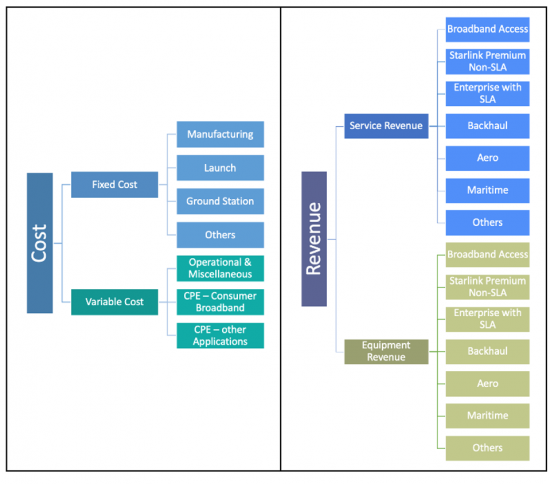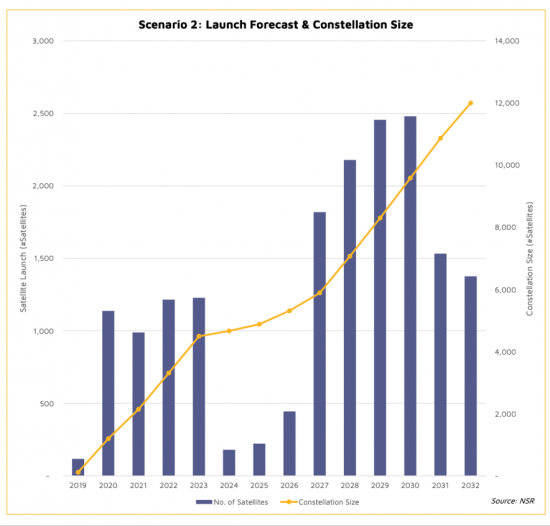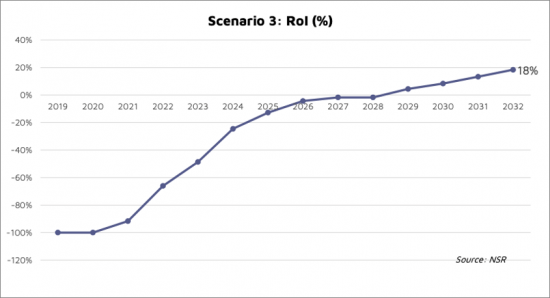 |
市場調查報告書
商品編碼
1259078
星鏈可行性:商業模式和投資回報率分析Starlink Feasibility: Business Model and ROI Analysis |
||||||
本報告對 Starlink 進行了研究,並對其業務模式和未來成功潛力以及成本和收入預測進行了全面分析。
報告摘要
本報告審視 Starlink 業務的健康狀況並評估其業務模式的可持續性。
星鏈衛星發射和寬帶用戶獲取的快速步伐擾亂了衛星通信行業。 因此,行業利益相關者必須了解影響星鏈價值主張的因素並評估其商業模式的可持續性。
本報告利用 NSR 在各種衛星通信應用(包括製造、發射和地面運營)方面的豐富專業知識,探討了 Starlink 當前和未來的優先事項。 它預測了多種成本和收入情景,並全面分析了星鏈的商業模式和未來成功的潛力。
>本報告深入探討了影響星鏈價值主張的因素,包括近地軌道 (LEO) 衛星星座對行業和最終用戶的影響。 我們的分析考察了星鏈的潛在市場份額及其寬帶用戶群的增長潛力。
我們還研究了有助於 Starlink 業務模式可持續性的因素,包括成本控制策略、收入機會以及抵禦潛在行業逆風的能力。

NSR 致力於提供準確、全面的市場分析,幫助我們的客戶做出明智的決策。 這份星鏈可行性報告為衛星通信行業利益相關者提供了評估星鏈商業模式的可持續性和未來計劃所需的信息。
本報告將回答關鍵問題。
- 構建不同星座尺寸的星鏈星座的總成本是多少?
- 在不同的市場場景下,Starlink 的總收入是多少?
- 未來幾年,Starlink 在各個目標市場將如何發展?
- Starlink 的商業模式是否可持續且有利可圖?
此報告的購買者
Starlink 是影響整個連接市場的主要參與者。 行業利益相關者推薦該報告來了解星鏈在不同案例和場景下的未來計劃、收入和可持續性。 以下是價值鏈中各個參與者的主要收穫:
- 投資者 -了解收入機會、成本、利潤、IRR、現金流等。
- 服務提供商和設備製造商 - Starlink 的商業模式是否可持續? 還了解對競爭的影響
- 衛星運營商和航天機構 - 星鏈未來的發射和收入預測、星座建設成本
- 運營商和移動網絡運營商 - 評估 Starlink 帶來的市場目標、收入潛力、機遇和威脅
與 NSR 的區別
NSR 以其預測衛星行業市場動態並保持領先地位的能力而聞名。 在這個巨大變革的時代,NSR 是一個有價值的合作夥伴,可以幫助塑造衛星通信生態系統中非 GEO 和 GEO 市場的願景。 這份有價值的報告是對星鏈價值主張和相關成本的公正分析。 了解星鏈對於希望在衛星通信生態系統中有效定位的公司至關重要。
主要功能
本報告通過考慮不同場景下的成本和收入,對星鏈的業務案例和盈利能力進行了公正的評估。 該報告估計並分析了關鍵變量,例如按部門劃分的固定成本、按部門劃分的可變成本、按應用劃分的服務收入、按應用劃分的設備收入、損益、現金流、內部收益率和投資回報率。
本研究的範圍
- 此新功能 - 業界首個基於場景的 Starlink 業務案例評估
- 基於場景的固定和可變成本估算
- 按應用劃分的 Starlink 服務和設備收入
- 按場景劃分的投資回報率、內部收益率、損益預測
報告細分:



內容
簡介
情景定義和研究方法
執行摘要
第1章:星鍊是否有利可圖?
- 場景 1 - 損益、盈虧平衡點、現金流、IRR
- 場景 2 - 利潤/虧損、盈虧平衡點、現金流、IRR
- 場景 3 - 利潤/虧損、盈虧平衡點、現金流、IRR
第2章星鏈成本評估
- 場景 1 - 發射預測和星座規模
- 場景 1 - 固定成本和可變成本
- 場景 2 - 發射預測和星座規模
- 場景 2 - 固定成本和可變成本
- 場景 3 - 發射預測和星座規模
- 場景 3 - 固定成本和可變成本
第3章星鏈盈利預測
- 情景 1 - 服務和設備收入
- 情景 2 - 服務和設備收入
- 情景 3 - 服務和設備收入
第4章結論
Report Summary:
Our latest report, NSR's “Starlink Feasibility: Business Model and ROI Analysis” examines the health of Starlink's business and assesses the sustainability of its business model.
Starlink's rapid pace of satellite launches, and broadband subscriber acquisition has caused disruption in the Satellite Communications industry. As a result, it's essential for industry stakeholders to understand the factors that affect Starlink's value proposition and assess the sustainability of its business model.
Leveraging NSR's extensive expertise across various Satcom applications, including manufacturing and launch, as well as ground segment operations, our report scrutinizes Starlink's current and future priorities. We have forecasted multiple cost and revenue scenarios to provide a comprehensive analysis of Starlink's business model and its potential for success in the future.
“Starlink Feasibility: Business Model and ROI Analysis” delves deep into the factors that affect Starlink's value proposition, including the impact of its low Earth orbit (LEO) satellite constellation on the industry and the end-users. Our analysis examines the potential market share that Starlink could capture and the growth potential of its broadband subscriber base.
Our report also provides insights into the factors that contribute to Starlink's business model's sustainability, including cost management strategies, revenue generation opportunities, and its ability to withstand potential industry headwinds.

At NSR, we are committed to providing accurate and comprehensive market analysis to enable our clients to make informed decisions. Our report on Starlink's feasibility provides stakeholders in the Satellite Communications industry with the information they need to assess the sustainability of Starlink's business model and plan for the future.
Key questions are answered in this report?
- What is the total cost to build the Starlink constellation for different Constellation Sizes?
- What will be the total revenue capture by Starlink, under different market scenarios?
- How will Starlink progress across different target markets in the coming years?
- Will the Starlink business model be sustainable and profitable?
Who Should Purchase this Report:
Starlink is a major player impacting the overall connectivity market. Industry stakeholders should read the report to understand Starlink's future plan, revenue and sustainability for different cases or scenarios. Below are the key takeaways for different players in the value chain:
- Investors - to understand the revenue opportunities, Costs, Profits, IRR, Cash Flow, etc.
- Service Providers & Equipment Manufacturers - whether the Starlink business model is sustainable or not? Also, to understand the competitive impact.
- Satellite Operators & Space Agencies - Starlink future launch and revenue projections, costs to build the constellation.
- Telcos and MNOs - to assess market targets, revenue potential and opportunities & threats posed by Starlink.
The NSR Difference
NSR is renowned for its ability to anticipate market dynamics and stay ahead of the curve in the satellite industry. In the midst of a profound transformation, NSR is a valued partner in helping shape the vision of both Non-GEO and GEO markets in the Satellite Communication ecosystem. This valuable report provides an unbiased analysis of Starlink's value propositions and associated costs. Understanding Starlink is crucial for any company looking to position itself effectively within the Satcom ecosystem.
Key Features:
NSR's “Starlink Feasibility: Business Model and ROI Analysis” offers an unbiased assessment of Starlink's business case and profitability, considering various scenario-based costs and revenues. The report estimates and analyzes key variables, such as Segmented Fixed Costs, Segmented Variable Costs, Service Revenues by Application, Equipment Revenues by Application, Profits/Losses, Cash Flow, IRR, and RoI.
Covered in this Report:
- NEW in this Edition - Industry's first Scenario-based evaluation of Starlink Business Case.
- Scenario based Fixed and Variable Cost estimations.
- Starlink's Service and Equipment revenues by Applications
- RoI, IRR and Profit / Loss estimations by scenarios.
Report Segmentation:



Companies mentioned in this Report:
Starlink, SpaceX, Viasat, OneWeb, Hughes, Kuiper, Telesat, SES.
Table of Contents
Introduction
Scenario Definitions & Methodology
Executive Summary
1. Will Starlink be Profitable?
- 1.1. Scenario 1 - Profit/Loss, Break-Even, Cash Flow and IRR
- 1.2. Scenario 2 - Profit/Loss, Break-Even, Cash Flow and IRR
- 1.3. Scenario 3 - Profit/Loss, Break-Even, Cash Flow and IRR
2. Starlink Cost Assessment
- 2.1. Scenario 1 - Launch Forecast and Constellation Size
- 2.2. Scenario 1 - Fixed and Variable Costs
- 2.3. Scenario 2 - Launch Forecast and Constellation Size
- 2.4. Scenario 2 - Fixed and Variable Costs
- 2.5. Scenario 3 - Launch Forecast and Constellation Size
- 2.6. Scenario 3 - Fixed and Variable Costs
3. Starlink Revenue Projections
- 3.1. Scenario 1 - Service & Equipment Revenues
- 3.2. Scenario 2 - Service & Equipment Revenues
- 3.3. Scenario 3 - Service & Equipment Revenues
4. Bottom Line
List of Exhibits
- 1. RoI by Scenario
- 2. Annual Cost by Scenario
- 3. Annual Revenue by Scenario
- 4. Annual Profit / Loss by Scenario
- 5. Scenario 1: Cost Versus Revenue
- 6. Scenario 1: Cash Flow & IRR
- 7. Scenario 1: RoI (%)
- 8. Scenario 2: Cost Versus Revenue
- 9. Scenario 2: Cash Flow & IRR
- 10. Scenario 2: RoI (%)
- 11. Scenario 3: Cost Versus Revenue
- 12. Scenario 3: Cash Flow & IRR
- 13. Scenario 3: RoI (%)
- 14. Scenario 1: Launch Forecast and Constellation Size
- 15. Scenario 1: Fixed Cost (Includes Manufacturing & Launch)
- 16. Scenario 1: Variable Cost (Includes CPE Cost)
- 17. Scenario 1: Total Cost
- 18. Scenario 2: Launch Forecast and Constellation Size
- 19. Scenario 2: Fixed Cost (Includes Manufacturing & Launch)
- 20. Scenario 2: Variable Cost (Includes CPE Cost)
- 21. Scenario 2: Total Cost
- 22. Scenario 3: Launch Forecast and Constellation Size
- 23. Scenario 3: Fixed Cost (Includes Manufacturing & Launch)
- 24. Scenario 3: Variable Cost (Includes CPE Cost)
- 25. Scenario 3: Total Cost
- 26. Scenario 1: Service Revenues by Application
- 27. Scenario 1: Equipment Revenues by Application
- 28. Scenario 1: Total Revenues
- 29. Scenario 2: Service Revenues by Application
- 30. Scenario 2: Equipment Revenues by Application
- 31. Scenario 2: Total Revenues
- 32. Scenario 3: Service Revenues by Application
- 33. Scenario 3: Equipment Revenues by Application
- 34. Scenario 3: Total Revenues













